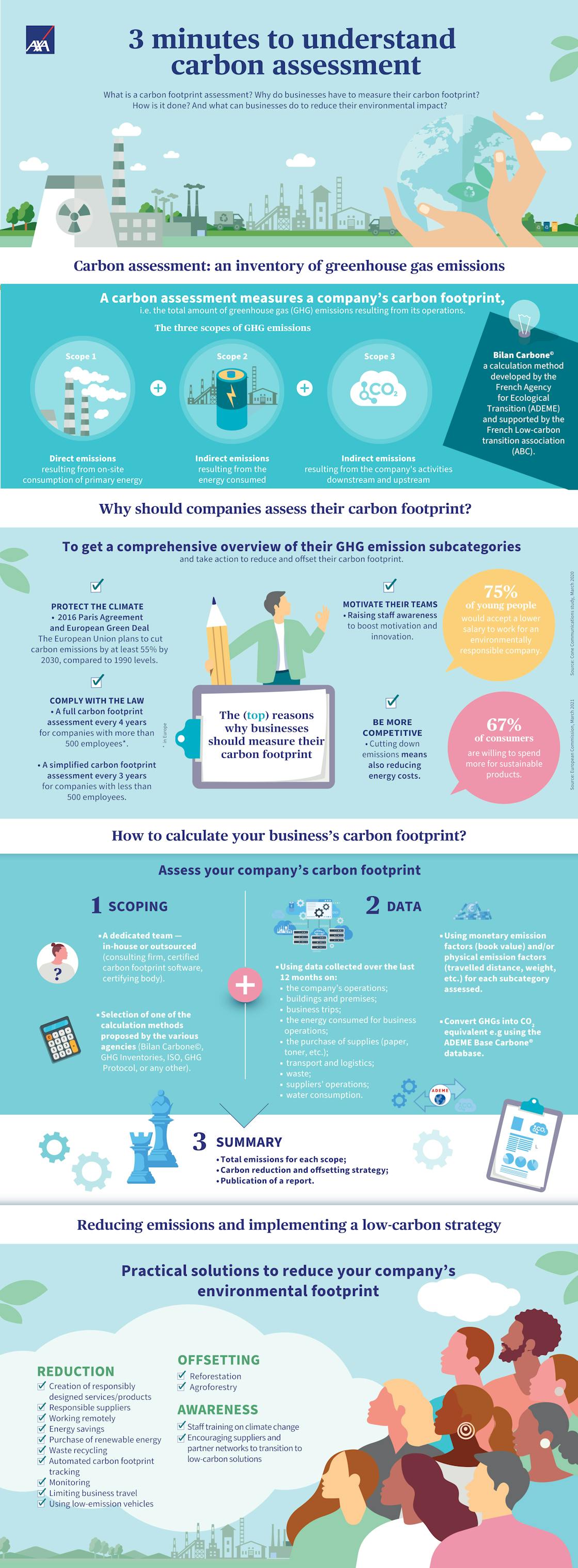
new-hazards|3 mins Read
October 24, 2022
The carbon assessment measures the quantities of greenhouse gases emitted into the atmosphere as a result of anthropogenic activities, particularly those of companies. But measuring them is not an objective in and of itself. Initiatives then need to be implemented at the company in question in order to reduce these emissions. Why undertake a complete carbon assessment? How? What actionable solutions are available to companies to help them become less carbon intensive? Our infographic will help you understand the company carbon assessment.
Following the 2016 Paris Climate Accords, the European Union pledged to reduce its own greenhouse gas emissions by 55% by 2030, compared with 1990 levels, and to reach net zero by 2050 so as to help tackle climate change. For this to be possible, all public and private stakeholders must play their role. The carbon assessment is a fundamental approach and an effective means of assessing one’s greenhouse gas emissions with a view to reducing them.

At the start of the 2000s, companies of all sizes realised the importance and benefits of determining the carbon footprint of their activities. Doing so provides them with a global understanding of sources of greenhouse gas emissions so that they can put in place initiatives to reduce and / or offset them. Greenhouse gas emissions are evidence of just how dependent our activities are on fossil energies. As energy costs increase, companies are realising just how dependent they are on them, and that they need to reduce their energy consumption. ADEME (the French Agency for the Environment and Energy Management) even talks in terms of companies’ carbon vulnerability.
As the computer graphic shows, in addition to being a set of regulatory obligations – a complete carbon assessment for companies of more than 500 employees (and a simplified one for companies of under 500 employees) – the carbon assessment is a tool that enhances the competitiveness and appeal of companies.
A carbon or greenhouse gas assessment looks at all of the greenhouse gas emissions generated by what a company does. There are a number of ways of calculating them, including the ADEME’s Bilan Carbone© method in France, and the GreenHouse Gas (GHG) Protocol internationally.
Greenhouse gas emissions are divided into three scopes, depending on what type they are. These are linked – to varying degrees – with what the company does. For most companies operating in the tertiary sector, these emissions tend to be indirect. They are generated by these companies' suppliers and users. This makes it difficult to calculate them, but they have a significant impact on the overall assessment.
For each scope, the person or people in charge of undertaking the carbon assessment must collect all data associated with the company's activity over the last 12 months. This might be information that is already available at the company, or it could be external data that will need to be gathered from suppliers, clients, users etc. Or it could be statistical data or the results of studies. This data is then converted into carbon dioxide equivalent (CO2 eq.) using the ADEME’s Base carbone® method in France, or other platforms such as Ecoinvent internationally.
It is then summarised in a report. But that's only half the job done! The carbon assessment also needs to include a transition plan with carbon reduction and offsetting proposals, as well as details of how change can be managed across the company.
In April 2022, the Intergovernmental Panel on Climate Change (IPCC) published its report on mitigating the effects of climate change. The report is an overview of solutions on all scales for collectively reducing our greenhouse gas emissions and minimising the consequences of climate change at a global level.
Once they have had a carbon assessment undertaken, companies can identify the main sources of greenhouse gas emissions across their activities and implement actionable solutions for reducing their environmental impact.
Forming part of a transition plan, these reduction initiatives can come in several guises, as detailed below.
The methods used to produce the products and / or services delivered by the company can be optimised across their entire value chain so as to reduce their greenhouse gas emissions:
The company's strategic vision and the way in which its services operate are also key areas in which changes can be made for reducing its environmental impact:
First and foremost, a company is a collective. And the way in which work is structured and people's individual habits also have a significant impact:
(*Working from home reduces individual transport, but it can increase heating and lighting requirements if optimised arrangements are not put in place.)
What cannot be reduced can be offset. This involves supporting stakeholders with the resources to store carbon, particularly associations engaged in reforestation or agroforestry.
As you have seen, conducting a carbon assessment of a company is a fully-fledged commitment to the ecological transition. In 2020, AXA Partners France conducted a comprehensive carbon assessment with Greenly, factoring in emotions associated with our buildings (energy, water consumption, waste production and management), our business travel (by plane, train and in AXA vehicles) and our employees’ trips, as well as those of our suppliers and partners. Other entities making up AXA Partners will conduct similar assessments, and appropriate environmental strategies will be adopted by each one.
A few resources to find out more about the carbon assessment: